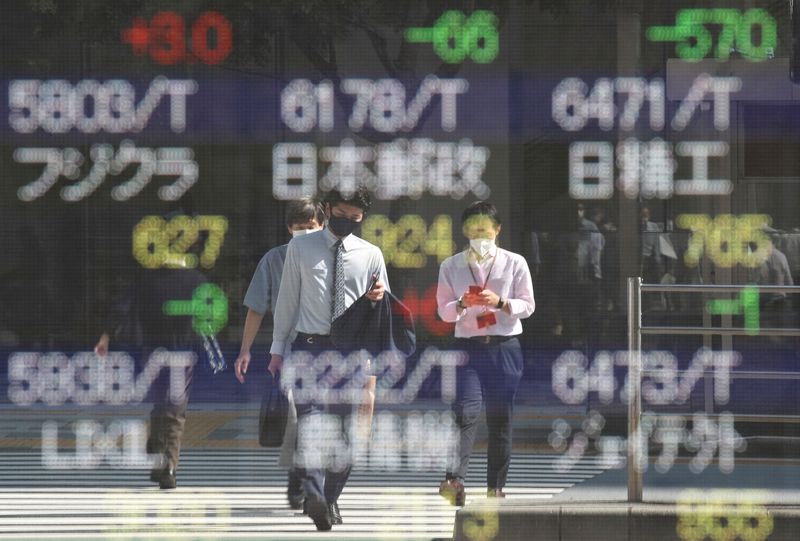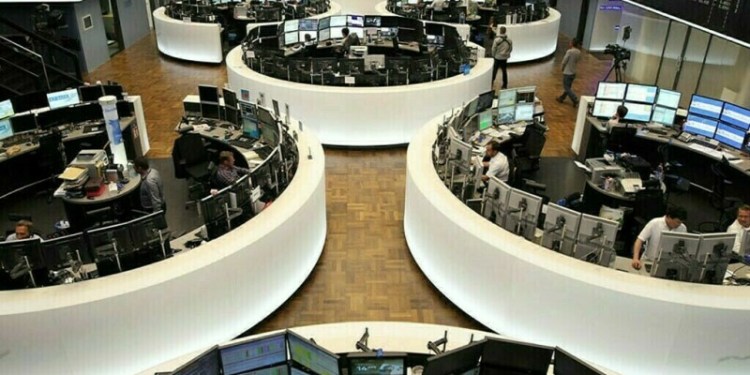
© Reuters. People wearing protective masks, amid the coronavirus disease (COVID-19) outbreak, are reflected on an electronic board displaying Japan’s stock prices outside a brokerage in Tokyo, Japan, October 5, 2021. REUTERS/Kim Kyung-Hoon
By Paulina Duran
SYDNEY (Reuters) – Asian stocks were mostly down and oil prices slipped on Tuesday as the spread of the Omicron coronavirus variant rattled investors who were already on edge ahead of a slew of central bank decisions this week, including a key Federal Reserve meeting.
MSCI’s broadest index of Asia-Pacific shares outside Japan was down 0.77%, as the Asian Development Bank (ADB) trimmed its growth forecast for developing Asia, reflecting risks brought on by the new virus variant.
China’s CSI300 index was 0.39% lower, after health authorities in Tianjin detected the country’s first Omicron case, while Britain reported the first death from the variant.
Hong Kong’s Hang Seng Index was down 1.2%, also dragged down by persistent concerns over the health of China’s property sector.
The combination of economic risks from the Omicron variant and a potentially more hawkish tone from the Fed on Wednesday dampened risk appetite in Asia.
Still, stocks in the northern hemisphere could catch a breather, with E-mini futures for the S&P 500 index up 0.13% and FTSE futures 0.29% higher, pointing to a potential positive start for European markets.
“I think there are reasons why you might expect to see money go back into cash for a bit, in expectation that the start of 2022 is going to be a volatile period,” said John Milroy, an adviser at Ord Minnett in Sydney, citing “challenges, such as China’s slowdown and uncertainty around monetary policy, which we think will impact earnings and valuation multiples.”
Major Chinese manufacturing province Zhejiang is fighting its first COVID-19 cluster this year, with tens of thousands of citizens in quarantine and virus-hit areas suspending business operations.
The ADB projected China’s economy will grow 8.0% this year, slightly weaker than its 8.1% estimate in September, before it slows to 5.3% in 2022, down from its earlier projection of 5.5%.
South Korea’s KOSPI was 0.63% lower, Japan’s Nikkei stock index was down 0.86% and Australian shares were little changed.
MSCI’s gauge of stocks across the globe was 0.13% lower.
The Fed is on Wednesday expected to signal a faster wind-down of its $120 billion a month bond buying programme in a move to fight a high rate of inflation, which could move it one step closer to raising interest rates.
The dollar edged higher ahead of the upcoming meetings, with investors eyeing the possibility that the Fed will start to raise interest rates in 2022.
“Volatility will remain elevated throughout all of (these) decisions from the Fed, ECB, and BOE,” said Edward Moya, senior analyst at OANDA.
The European Central Bank, the Bank of England and the Bank of Japan are also meeting this week, and are each heading toward normalising their own monetary policies.
Fears over the Omicron variant of COVID-19 were heightened after British Prime Minister Boris Johnson warned of a “tidal wave” of new cases, and the World Health Organization said it poses a “very high” global risk, with some evidence that it evades vaccine protection.
Oil futures eased as new doubts emerged about the effectiveness of vaccines against the Omicron coronavirus variant, though OPEC predicted in its monthly report that the variant’s impact on fuel demand would be mild.
Brent futures were 22 cents, or 0.28% lower to be at $74.18 a barrel, while U.S. West Texas Intermediate (WTI) crude was 30 cents, or 0.38%, lower at $71.02.
The dollar index extended gains on Tuesday, rising 0.07%, with the euro down 0.07% to $1.1275, seen vulnerable given expectations the Fed will tighten policy more quickly than the ECB.
The benchmark U.S. 10-year Treasury yield traded little changed at 1.422% after falling on Monday as traders positioned for a hawkish Fed. [US/]
Source: Investing.com



























